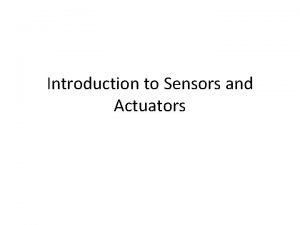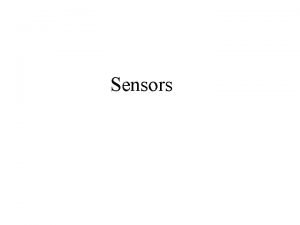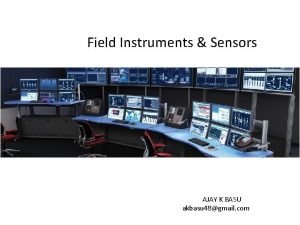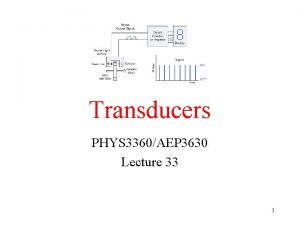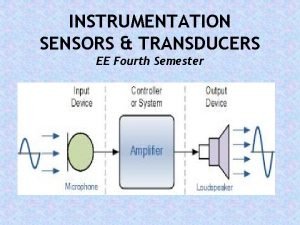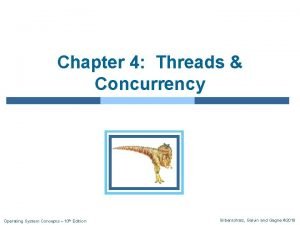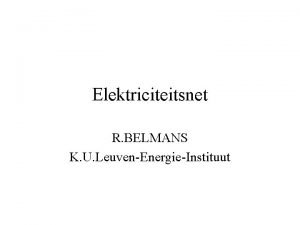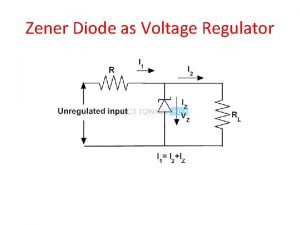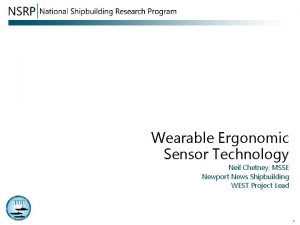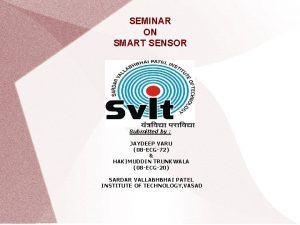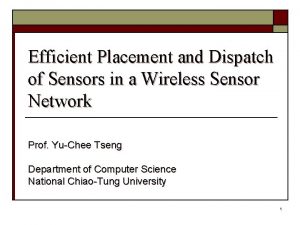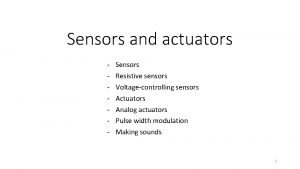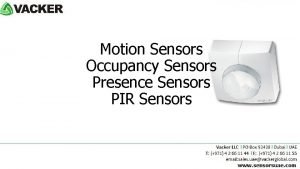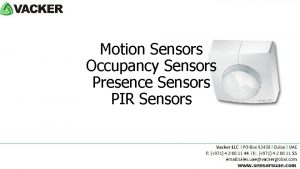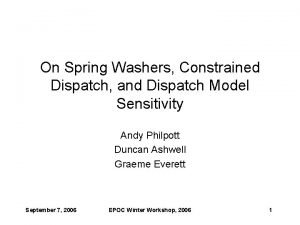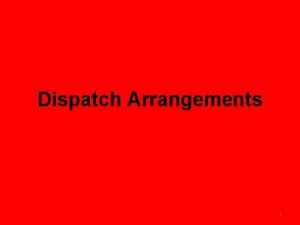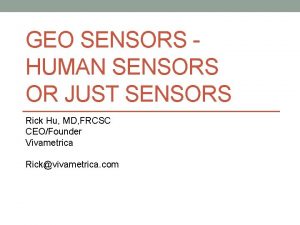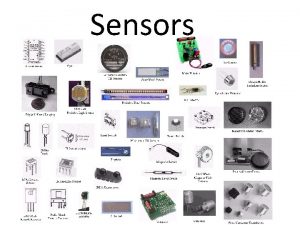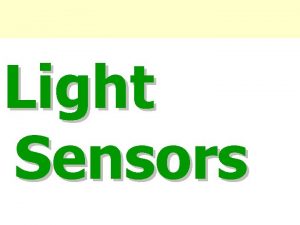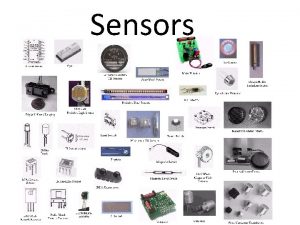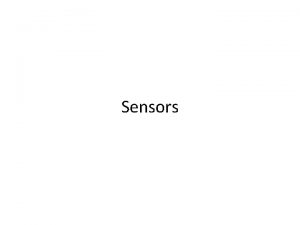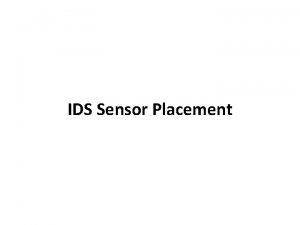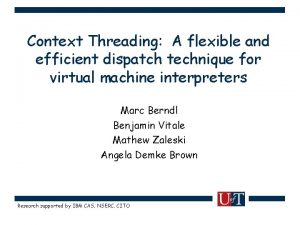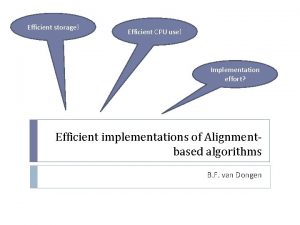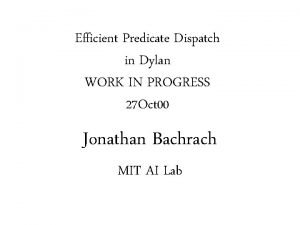Efficient Placement and Dispatch of Sensors in a











































- Slides: 43

Efficient Placement and Dispatch of Sensors in a Wireless Sensor Network Prof. Yu-Chee Tseng Department of Computer Science National Chiao-Tung University 1

Outline o o Introduction Sensor Placement Sensor Dispatch Conclusions 2

Introduction o Wireless sensor networks (WSN) n n n o Tiny, low-power devices Sensing units, transceiver, actuators, and even mobilizers Gather and process environmental information WSN applications n n n Surveillance Biological detection Monitoring 3

Introduction o o Sensor deployment is a critical issue because it affects the cost and detection capability of a wireless sensor network A good sensor deployment should consider both coverage and connectivity Coverage Connectivity 4

Review o o The art gallery problem (AGP) asks how to use a minimum set of guards in a polygon such that every point of the polygon is watched by at least one guard. However, the results cannot be directly applied to sensor deployment problem because n AGP typically assumes that a guard can watch a point as long as line-of-sight exists o n Sensing distance of a sensor is normally finite AGP does NOT address the communication issue between guards o Sensor deployment needs to address the connectivity issue 5

Two Issues in Sensor Deployment o Sensor placement problem: n o Ask how to place the least number of sensors in a field to achieve desired coverage and connectivity properties. Sensor dispatch problem: n Assume that sensors are mobilized n Given a set of mobile sensors and an area of interest I inside the sensing field A, to choose a subset of sensors to be delegated to I with certain objective functions such that the coverage and connectivity properties can be satisfied 6

Outline o o Introduction Sensor Placement Sensor Dispatch Conclusions 7

Sensor Placement Problem o Input: sensing field A n n A is modeled as an arbitrary-shaped polygon A may contain several obstacles o o o Each sensor has a sensing distance rs and communication distance rc n o Obstacles are also modeled by polygons Obstacles do NOT partition A But we do NOT restrict the relationship between rs and rc Our goal is to place sensors in A to ensure both sensing coverage and network connectivity using as few sensors as possible 8

Two Intuitive Placements Consider coverage first Need to add extra sensors to maintain connectivity when Consider connectivity first Need to add extra sensors to maintain coverage when 9

Proposed Placement Algorithm o Partition the sensing field A into two types of subregions: n Single-row regions o o n A belt-like area between obstacles whose width is NOT larger than , where rmin= min(rs, rc) We can deploy a sequence of sensors to satisfy both coverage and connectivity Multi-row regions o o We need multi-rows sensors to cover such areas Note: Obstacles may exist in such regions. 10

Step 1: Partition the Sensing Field o o From the sensing field A, we identify all single-row regions n Expand the perimeters of obstacles outwardly and A’s boundaries inwardly by a distance of rmin n If the expansion overlaps with other obstacles, then we can take a projection to obtain single-row regions The remaining regions are multi-row regions. 11

An Example of Partition Si gio e r w ro ngle- Mul ti-ro w re ns gion s 12

Step 2: Place Sensors in a Single-row Region o Deploy sensors along the bisector of region 13

Step 3: Place Sensors in a Multi-row Region o We first consider a 2 D plane without boundaries & obstacles n n n o Case 1: n n o Deploy sensors row by row A row of sensors needs to guarantee coverage and connectivity Adjacent rows need to guarantee continuous coverage Sensors on each row are separated by rc Adjacent rows are separated by Case 2: n Each sensor is separated by 14

Case 1: 15

Case 2: 16

Refined Step 3: o For a multi-row region with boundaries and obstacles, n We can place sensors one by one according to the following locations (if it is not inside an obstacle or outside the region) 17

Step 4: o Three unsolved problems n n n o Some areas near the boundaries are uncovered Need extra sensors between adjacent rows to maintain connectivity when Connectivity to neighboring regions needs to be maintained Solutions n Sequentially place sensors along the boundaries of the regions and obstacles 18

Simulation Results o Sensing fields 19

Simulation Parameters o o We use (rs, rc) = (7, 5), (5, 5), (3. 5, 5), (2, 5) to reflect the four cases Comparison metric n n Average number of sensors used to deploy Compare with two deployment methods Coverage-first Connectivity-first 20

Simulations (rs vs. rc) 21

Simulations (Shapes of A) 22

Outline o o Introduction Sensor Placement Sensor Dispatch Conclusions 23

Problem Definition o o We are given n A sensing field A n An area of interest I inside A n A set of mobile sensors S resident in A The sensor dispatch problem asks how to find a subset of sensors S’ in S to be moved to I such that after the deployment, I satisfies coverage and connectivity requirements and the movement cost satisfies some objective functions. 24

Example A I Mobile sensor 25

Example A I 26

Example A I 27

Two Objective Functions o Minimize the total energy consumption to move sensors n n o : unit energy cost to move a sensor in one step di : the distance that sensor i is to be moved Maximize the average remaining energy of sensors in S’ after the movement n ei : initial energy of sensor i 28

Proposed Dispatch Algorithm (I) o o Run any sensor placement algorithm on I to get the target locations L={(x 1, y 1), … , (xm, ym)} For each sensor , determine the energy cost c(si, (xj, yj)) to move si to each location (xj, yj)) n o Construct a weighted complete bipartite graph , such that the weight of each edge is n n w(si, (xj, yj)) = - c(si, (xj, yj)) , if objective function (1) is used; or as w(si, (xj, yj)) = ei - c(si, (xj, yj)), if objective function (2) is used 29

Proposed Dispatch Algorithm (II) o o o ^ ^ Construct a new graph ^ from ^ L is a set of |S|-|L| elements, each called a G, where virtual location. The weights of edges incident to L^ are set to wmin, where wmin ={min. weight in G}-1. Find the maximum-weight perfect-matching M on graph G^ by using the Hungarian method. ^, For each edge c(si, (xj, yj)) in M such that move sensor si to location (xj, yj) via the shortest path. n If , it means that we do not have sufficient energy to move all sensors. Then the algorithm terminates. 30

An Example of Dispatch I o C Initially, there are five mobile sensors A, B, C, D, and E A B E D 31

An Example of Dispatch I A 1 2 3 4 B E o C Run sensor placement algorithm on I to get the target locations L={(x 1, y 1), (x 2, y 2), (x 3, y 3), (x 4, y 4)} D 32

An Example of Dispatch I A 1 2 3 4 B E o Compute energy cost (assume =1) C D 33

An Example of Dispatch Construct the weighted complete bipartite graph G and assign weight on each o edge A 1 B 2 C 3 D 4 E S L Weights of edges (assume that all sensors have the same initial energy 40 & 1 st objective function is used) 1 2 3 4 A 31 28 32 29 B 29 29 31 31 C 30 36 29 32 D 26 27 38 30 E 7 5 10 9 34

An Example of Dispatch Construct the new graph G^ from G by adding |S|-|L| virtual locations o Weights of edges A 1 B 2 C 3 D 4 E 5 S L 1 2 3 4 5 A 31 28 32 29 4 Virtual location B 29 29 31 31 4 C 30 34 29 32 4 D 26 27 28 30 4 E 7 5 10 9 4 Min. 35

An Example of Dispatch Use the Hungarian method to find a maximum-weighted perfect-matching M o Weights of edges A 1 B 2 C 3 D 4 E 5 S L 1 2 3 4 5 A 31 28 32 29 4 B 29 29 31 31 4 C 30 34 29 32 4 D 26 27 28 30 4 E 7 5 10 9 4 36

An Example of Dispatch I A A 1 C 2 3 B 4 D B E Do not move o C D Move sensors to the target locations A 1 B 2 C 3 D 4 E 5 S L 37

Find the Shortest Distance d(si, (xj, yj)) o Find collision-free shortest path n n A sensor is modeled as a circle with a radius r Expand the perimeters of obstacles by the distance of r to find the collision-free vertices. Connect all pairs of vertices, as long as the corresponding edges do not cross any obstacle. Using Dijkstra’s algorithm to find the shortest path. 38

Find the Maximum-Weight Perfect-Matching 39

The Hungarian Method 40

Time complexity o The time complexity of our sensor dispatch algorithm is O(mnk 2 + n 3) n m: number of target locations in I n n n: number of mobile sensors k: number of vertices of the polygons of all obstacles and I 41

Simulations o o Greedy: sensors select the closest locations Random: sensors randomly select locations 42

Conclusions o We propose a systematical solution for sensor deployment n n Sensing field is modeled as an arbitrary polygon with obstacles Allow arbitrary relationship between rc and rs Fewer sensors are required to ensure coverage and connectivity An optimal-energy dispatch algorithm is presented to move sensors to the target locations under two energybased objective functions 43
 Productively efficient vs allocatively efficient
Productively efficient vs allocatively efficient Productively efficient vs allocatively efficient
Productively efficient vs allocatively efficient Productively efficient vs allocatively efficient
Productively efficient vs allocatively efficient Productively efficient vs allocatively efficient
Productively efficient vs allocatively efficient Productive inefficiency and allocative inefficiency
Productive inefficiency and allocative inefficiency Ortec routing and dispatch
Ortec routing and dispatch Application of mechatronics ppt
Application of mechatronics ppt Difference between sensors and actuators
Difference between sensors and actuators Advantages of lvdt
Advantages of lvdt Ajay sensors and instruments
Ajay sensors and instruments Transducers and sensors
Transducers and sensors Transducer
Transducer Ie 423
Ie 423 Sensors and traceability
Sensors and traceability Pueblo wildcad
Pueblo wildcad Da 5988 e
Da 5988 e Hytera smart dispatch
Hytera smart dispatch Hotshot dispatching service
Hotshot dispatching service Dynamic method dispatch in java javatpoint
Dynamic method dispatch in java javatpoint Accessible dispatch
Accessible dispatch Windows process scheduling
Windows process scheduling Grand central dispatch c++
Grand central dispatch c++ Integrated dispatch systems
Integrated dispatch systems Dispatch
Dispatch Central dispatch
Central dispatch Automated dispatch system
Automated dispatch system Seven state process transition diagram
Seven state process transition diagram Solaris dispatch table
Solaris dispatch table Dispatch anywhere mobile
Dispatch anywhere mobile Double dispatch
Double dispatch Thc and fitness
Thc and fitness Nj emd guidecards
Nj emd guidecards Labour dispatch system
Labour dispatch system Centrale dispatch kuleuven
Centrale dispatch kuleuven Ambulance dispatch system requirements specification
Ambulance dispatch system requirements specification Ch robinson queretaro
Ch robinson queretaro Zener diode as voltage regulator
Zener diode as voltage regulator Wearable inertial sensors
Wearable inertial sensors Ergonomic sensors
Ergonomic sensors Washroom
Washroom Conclusion of smart sensors
Conclusion of smart sensors Engine oil debris sensors
Engine oil debris sensors Sensors vs intuitives
Sensors vs intuitives Peas description examples in ai
Peas description examples in ai







